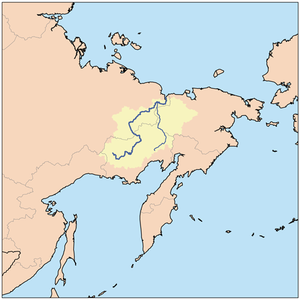
Cherskii
Encyclopedia

Kolyma River
The Kolyma River is a river in northeastern Siberia, whose basin covers parts of the Sakha Republic, Chukotka Autonomous Okrug, and Magadan Oblast of Russia. Itrises in the mountains north of Okhotsk and Magadan, in the area of and...
at 69°30′N 161°30′E in Northeast Siberia
Siberia
Siberia is an extensive region constituting almost all of Northern Asia. Comprising the central and eastern portion of the Russian Federation, it was part of the Soviet Union from its beginning, as its predecessor states, the Tsardom of Russia and the Russian Empire, conquered it during the 16th...
, and is used as a year-round base for international research in arctic biology, geophysics, and atmospheric physics. The station also houses the administration of the Pleistocene Park
Pleistocene Park
Pleistocene Park is a nature reserve south of Chersky in the Sakha Republic in northeastern Siberia, where an attempt is being made to recreate the northern steppe grassland ecosystem that flourished in the area during the last ice age.-Goals:...
, a local experimental wildlife preserve of 160 km2 where director Sergey Zimov
Sergey Zimov
Sergei Zimov is a Russian scientist who serves as the Director of the Northeast Science Station and is one of the founders of Pleistocene Park. He is best known for his work in advocating the theory that human overhunting of large herbivores during the Pleistocene caused Siberia’s grassland-steppe...
is restocking the area with reindeer, horses, moose, bison and musk oxen, which he believes were previously abundant, but exterminated by unsustainable hunting. Zimov hopes to also introduce native predators such as bears, wolves and Siberian tigers when the animal population is high enough. His grandest vision is the DNA
DNA
Deoxyribonucleic acid is a nucleic acid that contains the genetic instructions used in the development and functioning of all known living organisms . The DNA segments that carry this genetic information are called genes, but other DNA sequences have structural purposes, or are involved in...
recreation of the Woolly Mammoth
Woolly mammoth
The woolly mammoth , also called the tundra mammoth, is a species of mammoth. This animal is known from bones and frozen carcasses from northern North America and northern Eurasia with the best preserved carcasses in Siberia...
from an abundant supply of long-frozen carcasses.
Named after Russian explorer Jan Czerski
Jan Czerski
Jan Stanisław Franciszek Czerski was a Polish paleontologist , geologist, geographer and explorer of Siberia. He was exiled to Transbaikalia for participation in the January Uprising of 1863...
, Chersky is sited on frozen pleistocene
Pleistocene
The Pleistocene is the epoch from 2,588,000 to 11,700 years BP that spans the world's recent period of repeated glaciations. The name pleistocene is derived from the Greek and ....
carbon. The sediments here are made up of 50% ice, and 50% loess
Loess
Loess is an aeolian sediment formed by the accumulation of wind-blown silt, typically in the 20–50 micrometre size range, twenty percent or less clay and the balance equal parts sand and silt that are loosely cemented by calcium carbonate...
, which is a windblown sediment - the carbon content of loess deposits is five times that of a rainforest floor. During each annual melt between 2 and 5% of the stored carbon in the loess deposits is lost.

